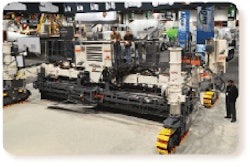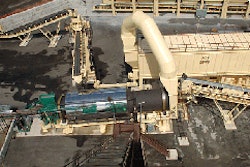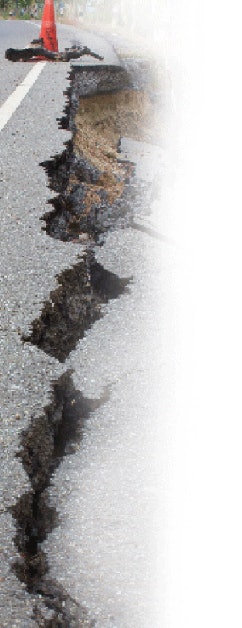
By Tom Kuennen, Contributing Editor
Integrated roadside management programs are being adopted at state and county road agencies because they combine the multiple missions of vegetation management, roadside beautification, motorist safety, erosion control and roadway appurtenance maintenance into one package.
By combining these missions, economies of scale are achieved and long-term results can be achieved. Like pavement and bridge preservation programs, or other asset management programs, roadside management programs can help administrators decide what outcomes will be best for a particular stretch of highway, and following a timeline, help the agency work toward that outcome over a period of years.
Gone are the days when roadside management meant just periodic mowing and spraying of weeds, biannual regrading of shoulders, and sporadic visits to sedimented drainage ditches with a wheel excavator. Today’s integrated plans incorporate these elements into a “tool box” of additional treatments or actions that are programmed over time for the best impact on the system and expenses.
“Vegetation is [just] one important element of roadside maintenance,” says the Minnesota DOT in its Best Practices Handbook for Roadside Vegetation Management, 2008-2020. “A healthy roadside environment reduces maintenance needs and costs, reduces erosion and improves water quality, improves water infiltration and reduces runoff, preserves the roadside surface, maximizes safety for vehicles and travelers, limits liability for the governing agency, maintains good public relations, improves the overall driving experience, and provides habitat for wildlife populations.”
Vegetation Control = Safety
Nonetheless, vegetation control as a means of ensuring motorist safety is the prime driver of the integrated roadside management movement.
“The primary objective in maintenance of roadside vegetation is to promote the safety of the highway user, preserve the highway infrastructure and control of legally designated noxious weeds where they occur on the right of way,” says the Washington State DOT. “Other considerations include protection and preservation of natural environment, preservation and enhancement of the natural scenic quality of the roadside, and the need to be a good steward of the forest along this corridor.”
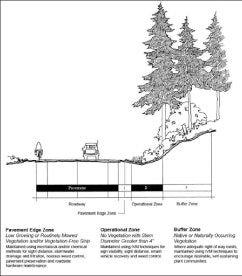 Washington State DOT – a leader in roadside vegetation management – defines different zones in the roadside, each with a different management strategy.
Washington State DOT – a leader in roadside vegetation management – defines different zones in the roadside, each with a different management strategy.In Washington State, roadside vegetation maintenance activities are planned and conducted to discourage or eliminate unwanted vegetation, and promote desirable vegetation. Like the pavement preservation timeline, integrated vegetation management principles include prevention of overgrowth or growth of noxious weeds, monitoring of conditions, determination of action thresholds and the proper timing of maintenance efforts, selection of the least-disruptive control and effective revegetation tactics, and continuing evaluation.
“The integrated vegetative management process provides information for the total roadside management system, which is used to analyze vegetation problems and implement long-term solutions,” WS DOT says. This broad overview approach helps vegetation managers answer key questions, such as whether treatment actions are needed, where they should take place in the system, when these actions should take place, and which mix of strategies, tactics and treatments are the best to use.
Very simply, roadside vegetation management involves caring for or controlling plants along the highway. “If managed properly, roadside vegetation can become self-sustaining over time and require less maintenance,” WS DOT says. “This helps reduce costs and minimizes herbicide use.”
Vegetation, if left alone, can grow out of control and block visibility (signs, traffic, wildlife) which could endanger motorists, WS DOT says. “Weeds must be controlled to avoid impacts on the farming community and native ecosystems,” it says. “Pride of ownership and the beauty of Washington State are also important factors, both aesthetically and economically, such as with the tourism industry.”
The plan constitutes a “how to” guide for the best way to manage roadsides in any given area. “Washington State has diverse climates and the highways have many neighbors, so the plans vary depending on location,” the state DOT says.
Echoing the mantra of the pavement preservation movement, WS DOT says “[t]he plans determine the right tool or combination of tools, for the right plant at the right place and time,” adding that is the essence of an integrated vegetation management plan.
WS DOT’s vegetation management tools include mowing and trimming, selective use of herbicides, release of weed-eating insects, improvement of soils, re-establishment of native plants, and hand-maintenance by volunteers or contract services. Their use is articulated in regional roadside vegetation management plans for each region inside each DOT district, necessary due to the extreme variation of environments within the Evergreen State, which range from high desert to alpine to urban to coastal rain forest.
Safety, Preservation in Bay State
Massachusetts’s current Vegetation Management Plan, 2009-2013 has a primary objective of providing a safe, unobstructed roadway corridor, and preserving the integrity of the highway infrastructure.
“Management of vegetation is an important element of roadside maintenance for safety and aesthetic purposes,” according to the plan. “Left uncontrolled, roadside vegetation can impede normal maintenance operations, obstruct motorists’ line of vision, threaten pedestrian safety and cause damage to structures such as median barrier, pavements, guard posts, drainage lines and waterways.”
“Left uncontrolled, roadside vegetation can impede normal maintenance operations, obstruct motorists’ line of vision, threaten pedestrian safety and cause damage to structures such as median barrier, pavements, guard posts, drainage lines and waterways.”- Massachusetts’s Vegetation Management Plan, 2009-2013
Other objectives include provision of an aesthetically pleasing roadside, pest control, creation of wildlife habitat, and stabilization of embankments and other areas prone to erosion.
The key components of Massachusetts Highway’s integrated program are identification of priorities for vegetation control, implementation of controls in an environmentally sensitive manner, and monitoring of performance to check methodology.
Like other states, Massachusetts is retaining use of herbicides. “Controls shall include mechanical, chemical, cultural, biological and roadside development methods,” the commonwealth states, adding “[i]t shall be a goal to minimize the use of chemical controls, through minimizing areas of application, quantity of chemicals, and frequency of applications. Chemical control techniques shall be limited to use on high traffic volume, high speed interstate and primary roadways in the commonwealth where safety of motorists, department employees and contractors precludes the use of mechanical methods.”
Mass Highways defines three classes of roadside vegetation:
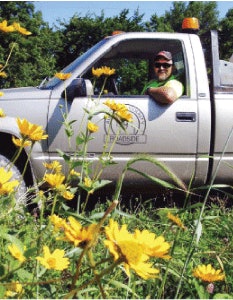 The State of Iowa is encouraging districts, counties and cities to improve roadsides with its Living Roadway Trust Fund.
The State of Iowa is encouraging districts, counties and cities to improve roadsides with its Living Roadway Trust Fund.• Hazard vegetation represents the primary target material, including vegetation obscuring sightlines, growing over guardrails, creating obstacles to signs or vehicular movement, posing windfall hazards over vehicular or pedestrian ways, or creating winter shade leading to icing conditions.
• Detrimental vegetation, including grasses and woody plants that are destructive to, or compromise the function of, highway structures, including grasses in pavement and bridge joints, medians, barriers and traffic islands, and vegetation growing in and along drainage structures, compromising drainage. Such vegetation creates storm water accumulation and hazardous icing conditions.
• Nuisance/noxious vegetation, including any vegetation growing along state roadways that could potentially cause problems to the general public or Mass Highway employees or contractors, usually poison ivy. Other nuisance vegetation may be growing within 30 feet of the edge of pavement, bridge abutments, a drainage structure or swale, other structures and appurtenances requiring maintenance, within state highway rights-of-way, are considered target vegetation.
• Invasive Vegetation includes ROW infestation with invasive plant species, including introduced plants that have spread from gardens and agricultural areas into the wild, where they pose problems for the natural environment.
Nebraska: Encourage Native Plants
In Nebraska, the Department of Roads’ Plan for the Roadside Environment promotes the increased use of native plantings and vegetation management to provide a sustainable roadside. The Cornhusker State emphasizes the use of native plantings adapted specifically to the varying climate zones across the state.
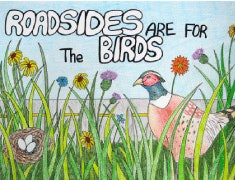 Seventh grader Vicky Evans of Cold Spring, Minn., drew this poster, which was a finalist in MnDOT’s “Roadsides are for the Birds” poster contest.
Seventh grader Vicky Evans of Cold Spring, Minn., drew this poster, which was a finalist in MnDOT’s “Roadsides are for the Birds” poster contest.Its roadside plan contains sections for each of the six landscape regions across Nebraska. Each individual landscape section contains regional maps and summarizes a variety of ecosystem information for the region, including hydrology, climate, and soil and plant communities, as well as regional history, land use, and economic features.
The plan is applicable to the entire state and includes landscaping objectives for integration into transportation system planning, safety, design and operation. Ultimate goals include good stewardship of roadsides, and maintenance of a unique and sustainable “Nebraska-style” landscape.
“The Plan for the Roadside Environment is designed to create a roadside that can better overcome the disturbances of construction, withstand the rigors of the Nebraska climate and perform the landscaping objectives that contribute to safe and maintainable roadsides that complement the surrounding landscape,” the plan states.
The plan is founded on the Nebraska Natural Legacy Project, a conservation plan published by the Nebraska Game and Parks Commission, and integrates environmental concerns, landscape objectives and mitigation and maintenance requirements.
Themes of Nebraska’s plan include:
• increased use of native plants appropriate to each landscape region of the state;
• seeding of native grasses, legumes and forbs in new ways as design elements to accomplish landscape objectives, as well as provide soil stabilization for the roadway corridor;
• use of required environmental mitigations in a manner that will accomplish landscape objectives within the highway corridor;
• use of permanent erosion control and stormwater control constructions as design features to accomplish landscape objectives within the highway corridor;
• development of additional ways to use plantings to reduce maintenance efforts and improve stewardship; and
• enhance existing partnerships and develop new partnerships with natural resource agencies and others to broaden benefits and to share knowledge and combine resources for mutual benefit.
If roadbuilding and maintenance changes the landscape, the roadside landscape must be maintained to recognize the movement of plants and animals, Nebraska DOT says. “These corridors provide a way for plants and animals to move between habitats that have been fragmented by agriculture, expanding communities and various other activities of man and nature,” Nebraska’s plan states. “Understanding this need and using thoughtful design and appropriate long-term management of these corridors will allow for safer movement of all species whether for seasonal migration or changes over longer periods of time.”
Iowa Funds County Roadsides
The state of Iowa is actively promoting integrated roadside vegetation management via a program that was established by the state in 1988.
Iowa’s tool chest includes judicious use of herbicides, spot mowing, prescribed burning, mechanical tree and brush removal and the prevention and treatment of disturbances to existing vegetation. Like Massachusetts, the plan’s long-term objective is to reduce roadside maintenance by creating stands of durable, long-lived, native plants.
Until the mid-1980s, Iowa’s roadside weed control relied exclusively on herbicides, with most counties using blanket spraying. It was expensive and potentially harmful, and it was an ineffective means of weed control, creating openings for weeds by stressing and weakening roadside grasses, and eliminating beneficial broadleaf species.
“Iowa counties were spending a lot of money putting large amounts of herbicide into the environment, and, at the same time, making little or no headway in the control of roadside weeds,” the plan says. “Clearly, this type of roadside management proved unsustainable.”
Simultaneously, the Iowa DOT began using native prairie grasses and wildflowers for erosion control. A few county conservation boards were also experimenting with this naturally adapted, alternative vegetation for roadsides. When the Iowa legislature officially adopted its integrated roadside vegetation management plan in 1988, the cornerstone of the program became the establishment and protection of native vegetation in Iowa roadsides.
To support roadside management, Iowa’s Living Roadway Trust Fund was created the following year, supporting state, city and county roadside projects.
“Since that time over 100,000 acres of state and county road right-of-way have been planted to native vegetation,” the plan says. “Diverse stands of 15 to 45 prairie grass and wildflower species – all naturally adapted to local growing conditions – provide stable, low-maintenance roadsides for Iowa.”
Simply by adopting an IRVM plan, a county or city becomes eligible to receive grant money from the trust fund for conducting an inventory of roadside conditions within the jurisdiction, and obtaining prairie grass and wildflower seed for roadside plantings.
By hiring a roadside manager, Iowa counties become eligible to receive Living Roadway Trust Fund money for equipment such as a native grass drill, hydro mulcher, straw mulch blower, GPS and software, prescribed burns, and seed harvesting. Funds also are made available for erosion control material, a seed storage facility, education and outreach materials, and for research. At this time some 39 Iowa counties now have full-time roadside managers.
According to the 2011 IRVM Technical Manual, herbicide use in Iowa roadsides has been reduced to spot-spray application, and the Iowa DOT and half of Iowa’s counties routinely plant native vegetation.
“When considering the establishment of a new IRVM program, consider: money spent in weed control, money spent in contract seeding, money spent contracting erosion control, money spent on erosion stone vs. best management practices,” says Wes Gibbs, Jones County roadside manager. “There’s lots of money to be saved with an IRVM program. Make it about money!”
Minnesota: Roadsides for Wildlife
Minnesota strives to maintain roadsides for safety and aesthetics at all levels of government, and articulates eight best management practices for roadsides at all levels of government:
• Develop an integrated roadside vegetation management plan
• Develop a public relations plan
• Develop a mowing policy and improved procedures
• Establish sustainable vegetation
• Control prohibited and restricted noxious weeds
• Manage living snow fences
• Use integrated construction and maintenance practices, and
• Manage roadside vegetation for wildlife and vehicle safety.
This last point has received special emphasis in the Gopher State. In 2011 it launched Roadsides are for the Birds, a promotion that stressed management of roadsides for all wildlife.
“Grassy roadsides can be for the birds!” MnDOT says. “Although these ribbons of green make up only a small fraction of our land area, researchers have found them to be highly productive nesting sites for more than 40 kinds of birds and animals that nest on the ground or in low vegetation. Examples include pheasants, gray partridge, rabbits, waterfowl, and songbirds.
“Roadsides represent over 500,000 acres of permanent grassland in Minnesota’s pheasant range,” the DOT says. “Unfortunately, many thousands of nest and nest sites are destroyed annually in southern and western Minnesota because of disturbance to our roadsides during spring and summer (late April through early August).”
To this end the state recommends delaying of roadside mowing of the ditch bottom and back slope until after August 1. “Each species of wildlife has its own nesting habits including when and how many times they rear young each year,” MnDOT says. “As a result, undisturbed roadside cover receives almost continuous nesting use from spring until late summer. By delaying roadside disturbance until after August 1, nests for most species can hatch successfully. A mowed strip along the shoulder is not damaging to nesting wildlife because most nests occur in the ditch bottom or back slope. Other disturbance factors that should be avoided include ‘blanket’ spraying, vehicle and tractor encroachment, and grazing. If possible, leave roadsides undisturbed year around.”
Roadsides mowed after September 1 should be clipped “high” as a minimum of 10 to 12 inches of erect, residual cover is vitally needed for next year’s early nesters, MnDOT says. Residual can also provide some roosting and escape cover. MnDOT provides free Roadsides for Wildlife signs that remind highway patrons of the mission.
Living snow fences are another way to enhance roadsides for wildlife while keeping roads clear of blowing snow, MnDOT says. “These linear shrub plantings and prairie grass snow catch areas provide significant nesting and brood cover for pheasants and other birds.” Financial incentives are available to encourage planting of living snow fences.
A road’s drainage system – however innocuous – is a major part of the integrated roadside management program. But drainage systems tend to be out-of-sight, and therefore often out-of-mind, leading to under-maintained drains that perform inefficiently or clog.
If drainage systems are not maintained, moisture will be retained in the structure and pavement deterioration will increase. If a road agency is unable to maintain its drainage systems, experts say, then it likely will be better served by designing a road structure without a drainage system.
A road drainage system can be degraded with aggregate, sand, clay or dirt from the pavement structure itself, from material and refuse dumped on the pavement, and by mud and gravel washed down in the roadside ditch.
Lastly, plastic and corrugated metal pipes can separate or be crushed, often during construction. That’s why systems should be inspected via video “snake” right after construction is completed, and then periodically thereafter. Maintenance forces should mow around the system outlet pipes at least two times each year, and should mow and clean roadside ditches as well.
A telescoping-boom, wheeled excavator is ideal for digging out clogged, silted drainage ditches, or for cutting weeds with an attachment. Headwalls protect outlet pipes, help limit erosion where there drainage system empties, and help workers identify the location of outlets, which otherwise might become overgrown or silted-in.
“The accumulation of sediment in culverts happens ‘out-of-sight and out-of-mind’ and that the very process of sedimentation, slow or sudden, is pervasive and nearly inevitable,” says Gerry Sackett, Gerryrigs, Charlottesville, Va.
“The hydraulic capacity of a culvert pipe is specified and is considered as a constant. The gradual accumulation of sediment within the culvert, and resulting reduction of design capacity are not factored in. It seems to be generally expected that the velocity of drainage flow will scour the barrel of a culvert and keep it clean, but in reality, this is not the case.”
Water may freely flow through an unencumbered culvert, and carry with it, particulate material in suspension, Sackett says. However, when the flow meets natural grade at the outlet of the pipe, the friction and irregularity of the natural grade (including stones, grass or debris) slows the current and makes it roll. Heavier particles (detritus and debris) settle out and the process of sediment accumulation is begun.
To reduce sedimentation of culverts, Sackett has developed the Culvert Inlet Protection Device, or CIPD, which was approved for testing by Virginia DOT in 2010 and by Georgia DOT in 2012.

